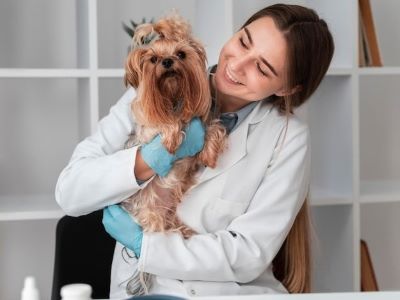Delve into the topic of vaginitis in dogs, exploring the causes, symptoms, and potential treatments for this common reproductive health issue. Navigate the signs and solutions to ensure the well-being of your canine companion.

Key Takeaways
- Vaginitis in dogs is a common reproductive health issue with various causes.
- Symptoms include discharge, discomfort, and increased licking of the genital area.
- Timely veterinary intervention and proper hygiene are crucial for managing and preventing vaginitis in dogs.
What Is Vaginitis in Dogs?
In simple terms, vaginitis is inflammation in female dogs and causes redness and swelling. It can appear in any dog at any age, spayed or intact.
“In puppies, it is usually a harmless condition that resolves on its own after its estrus (heat cycle), but older dogs usually need treatment“, states Dr Stephanie Howe at PetMD. Let’s understand the causes behind this condition:
1. Infections
Bacteria and yeast can infect the vagina and cause inflammation. If a dog has poor hygiene or a weak immune system, harmful bacteria like Streptococcus and E. coli can more easily infect the vaginal area leading to vaginitis.🦠

This is the most common cause. Just like humans, dogs can also get yeast infections that cause vaginal itching and discomfort.
2. Foreign Objects
Sometimes foreign things like grass seeds, small stones, or sticks can get stuck in the vagina. This irritates the tissue and can introduce infection.☘️
Some dogs may be sensitive to certain foods, soaps, or other substances that come in contact with the vaginal area, resulting in inflammation.
3. Physical Changes
Hormonal changes, especially in unspayed dogs, can contribute to vaginitis.
Overweight dogs that have excessive skin folds near their genitals can harbour bacteria in a warm, moist environment that promotes infection.🔁
Dogs that have frequent urinary accidents and constant urine moisture around the vagina are also prone to infection and inflammation. Dogs with recurring urinary tract infections can sometimes get secondary vaginitis as well.

Symptoms of Vaginitis in Dogs
In vaginitis often dogs have decreased appetite. The discomfort and swelling in the vagina can make urinating difficult and painful. Let’s look at some other symptoms:
- The discharge may be yellow, green, or brown, and can be watery or thick and mucus-like. The amount, colour, and texture of the discharge can help identify the type of infection.
- The tissues of the vagina become inflamed, making the vulva swollen, red, and irritated looking. This happens as the vagina reacts to the infection.
- Dogs with vaginitis often excessively lick their vulva area because it feels irritated. The increased licking can make the inflammation worse. A dog with vaginitis may cry or snap when the rear end is touched or when urinating due to discomfort.🚫
- Severe inflammation and irritation can sometimes cause bleeding from the vagina. This bleeding is usually mild. Some bacterial or yeast infections that cause vaginitis can result in a fever, indicating a spreading infection.
This condition should not be ignored, if you suspect this then immediately consult with your vet. One of the most common signs of vaginitis is abnormal vaginal discharge.

Diagnosis and Treatment
Diagnosis is most often based on medical history and clinical signs.
“Diagnostic tests can include blood and urine tests, urine culture and antibiotic sensitivity tests, vaginal cultures, and vaginal cytology studies. Additional tests, such as ultrasound or contrast X-rays, can help rule out anatomic abnormalities”, confirms Dr Ryan Llera from WebMD.🏥
The vet may prescribe Medications after the examinations, if a bacterial infection is found, the vet will prescribe antibiotics to clear the infection. For yeast infections, antifungal medications are used to kill excess yeast and allow normal balances to be restored.
These drugs reduce swelling and pain in the inflamed vaginal tissues. Sometimes cream and ointments are also prescribed to help dogs feel soothe in that area. Some vets may prescribe steroids, antihistamines or antibiotics to treat an infection.
In ovarian remnant syndrome, pyometra, and vaginitis it is crucial to keep dogs hygienic. Keep the dog's vaginal area clean and dry[1]. Gently cleaning the outer vulvar area helps remove pollutants and prevent repetition.
It is very important to address any underlying cause that is contributing to the issue of vaginitis. We may need to fix hormonal imbalances in dogs if they are contributing to this condition. Proper treatment and consistent help from the vet can improve a dog’s condition.

How to Prevent Vaginitis in Dogs?
Regularly clean your dog’s vaginal area. Make sure to rinse thoroughly and pat the area dry with a clean towel after cleaning. With proper care and help from the vet can prevent this condition in dogs, let’s look at some advanced tips:
- Hygiene: During your dog’s heat cycle, pay extra attention to keeping the area clean. You can use mild baby wipes or a damp cloth to gently clean if needed. This helps reduce the risk of infection.🪥
- Spaying: Spaying your dog can help prevent vaginitis, especially if your dog experiences recurring episodes. Spaying reduces hormonal fluctuations and the chances of developing infections.
- Allergies: If your dog has allergies that cause skin irritation like dermatitis in dogs, work with your vet to manage them effectively. Allergies can contribute to vaginal irritation and should be addressed to prevent vaginitis.
- Avoid Irritants: Avoid using harsh soaps, shampoos, or detergents on your dog that might irritate the sensitive vaginal area. Use pet-friendly products.🚫
- Balanced Diet: Nutritious food helps strengthen the immune system, reducing the risk of infections. Keep your dog at a healthy weight to prevent excess skin folds and moisture around the vaginal area. 🥣
- Outdoor Activities: When your dog plays outdoors, keep an eye on her to prevent her from picking up foreign objects like sticks or seeds that can lead to vaginal irritation.
Ensure your dog has access to clean water and take her out for regular bathroom breaks. Proper urination and hydration can help prevent urinary tract infections, which can sometimes lead to vaginitis.
If your dog has allergies, work with your vet to manage them effectively with things like antihistamine for dogs. Allergies can contribute to vaginal irritation and should be addressed to prevent vaginitis.
FAQs
❓Does Vaginitis Go Away on Its Own?
It isn’t a good idea to wait for vaginitis to disappear unless you know what’s causing it. For instance, some mild yeast infections go away independently, but not all cases do. Bacterial vaginosis usually clears up on its own but left untreated, it can put you more at risk for STIs.
❓What Is Vaginitis in Dogs?
The most common clinical signs of vaginitis include increased frequency of urination, licking of the vaginal area, vaginal discharges of mucus, pus, or blood (rarely), and scooting or rubbing of the vaginal area. The vagina will often appear red and swollen.
❓Why Is My Female Dog’s Private Area Swollen and Red?
If a female dog has not been spayed, the appearance of her vulva can change dramatically over the course of her heat cycle. When a dog is in heat (receptive to mating), her vulva becomes swollen, and a bloody discharge will be evident. This heat period usually lasts a week or two but can vary widely between dogs.
❓What Is the Treatment of Vaginitis in Dogs?
In more severe cases, antibiotics or surgery may be required. Antibiotics are often prescribed when bacterial infections are in the vulva, vagina, or urinary tract.
Summary
In conclusion “What Is Vaginitis in Dogs?” Vaginitis is an infection in female dogs that causes inflammation and other health issues. In order to protect our dogs from this condition we must act quickly in symptoms also with the help of a vet we can easily defeat this condition.🐶
With proper treatment from a vet, which may include antibiotics, antifungals, steroids, or even antihistamine for dogs, we can help our dogs overcome issues like vaginitis.
Remember as responsible dog lovers it is up to us to provide our dogs with a healthy and happy life!
Reference:
- Scully, C. M. (2023, October 5). Vaginitis in small animals. MSD Veterinary Manual.



